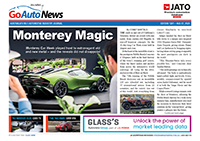 1 Nov 1994
1 Nov 1994
THE third-generation 7 Series (E38) brought significant improvements in handling, ride, refinement and comfort abilities, as well as impressive safety attributes.
But it suffered for its bland styling, which made it look like a stretched E36 3 Series. This was to help lead to a radical rethink when the E38’s bold successor was released seven years later.
Initially three existing engine variants were released – the 160kW/290Nm 3.0-litre six-cylinder 730iL, the 210kW/400Nm 4.0-litre V8 740iL and the flagship 240kW/490Nm V12 750iL.
All E38s featured five-speed automatic transmissions, with a sequential-shift facility incorporated from July ’96 – except in the V12 750iL, which had to wait until late ’98 for it.
In the beginning all were only offered in the long-wheelbase body, and continued as such to June 1996 when another round of engine upgrades arrived.
A 3.5-litre DOHC 32-valve V8 powered the 735iL, giving out 173kW and 345Nm. Launched in August ’96, it usurped the 730iL.
Meanwhile the 740iL badge continued despite it receiving a 4.4-litre DOHC 32-valve V8 producing an identical 210kW and 420Nm.
The regular wheelbase E38 finally arrived in Australia in October ’98, just in time for a minor facelift and another engine overhaul – the 3.5 V8 in the new 735i and upgraded 735iL now produced 175kW and 345Nm while the 4.4 V8 in the 740iL pumped out 210kW and 440Nm.
An extra-long wheelbase E38 L7 range-topper was released in October ’98, aimed primarily at the once-booming Asian economies. It was powered by the 240kW/490Nm 5.0 V12 engine but featured even more rear legroom than the already-long 750iL model – courtesy of a 5.37 metre long body.
The High-Line editions from early 2001 were the E38 7 Series models with extra standard equipment.
In total 327,599 E38s were manufactured by BMW between 1994 and 2001.
















